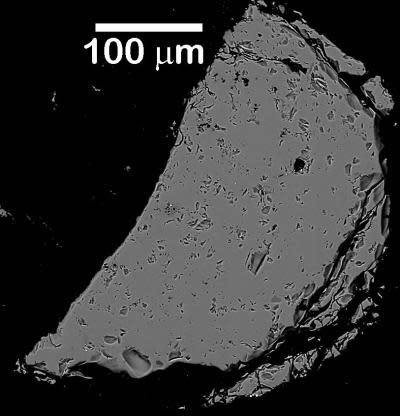What's Inside the Moon; The End of Moore's Law

Discovered: What the moon's insides look like, the tiniest transistor of all time, climate change is killing alpine chipmunks, and get ready for test-tube hamburgers.
What the moon's insides look like. No broken bones, thank goodness. It's not even gross. Just a bunch of dense grey magma down there, actually. Using x-ray's scientists have discovered that just like our planet, the moon has magma insides. But unlike the Earth, moon magma is too heavy to produce volcanoes -- for now. As the moon cools, we might see some volcano actions, explains researcher Wim van Westrenen. "Today, the Moon is still cooling down, as are the melts in its interior," he said. "In the distant future, the cooler and therefore solidifying melt will change in composition, likely making it less dense than its surroundings. This lighter magma could make its way again up to the surface forming an active volcano on the Moon – what a sight that would be!" [Nature Geosciences]
The tiniest transistor ever, of all time, forever. Really: it doesn't get smaller than a single atom, which is just what scientists have accomplished, creating a single-atom transistor with "atomic precision." "To me, this is the physical limit of Moore's Law," said Gerhard Klimeck. "We can't make it smaller than this." Beyond pushing the law to its limit, a feat on its own, the also means smaller quantum computing is on the way. And, in this case, we think smaller is better. [Purdue University]
Climate change is killing alpine chipmunks. In today's depressing climate-related news, freaky weather patterns have forced the alpine chipmunk population of California's Yosemite National Park to higher ground, leading to a decline in the animal's genetic diversity. "Climate change is implicated as the cause of geographic shifts observed among birds, small mammals and plants, but this new work shows that, particularly for mountain species like the alpine chipmunk, such shifts can result in increasingly fragmented and genetically impoverished populations," said study lead author Emily Rubidge. "Under continued warming, the alpine chipmunk could be on the trajectory towards becoming threatened or even extinct." Hear that? Extinct. First the bees, now the chipmunks, what next? Human people? [UC Berkeley]
A step closer to test-tube burgers. "By generating strips of meat from stem cells researchers believe they can create a product that is identical to a real burger," writes The Telegraph. We will believe that only after this burger impostor participates in and wins a Ron Swanson burger-off. We don't have high hopes, but science continues to dream, however, replicating this stem cell process with cow cells and calf serum. "In October we are going to provide a proof of concept showing out of stem cells we can make a product that looks, feels and hopefully tastes like meat," said researcher Mark Post. That does not sound too encouraging. [The Telegraph]
